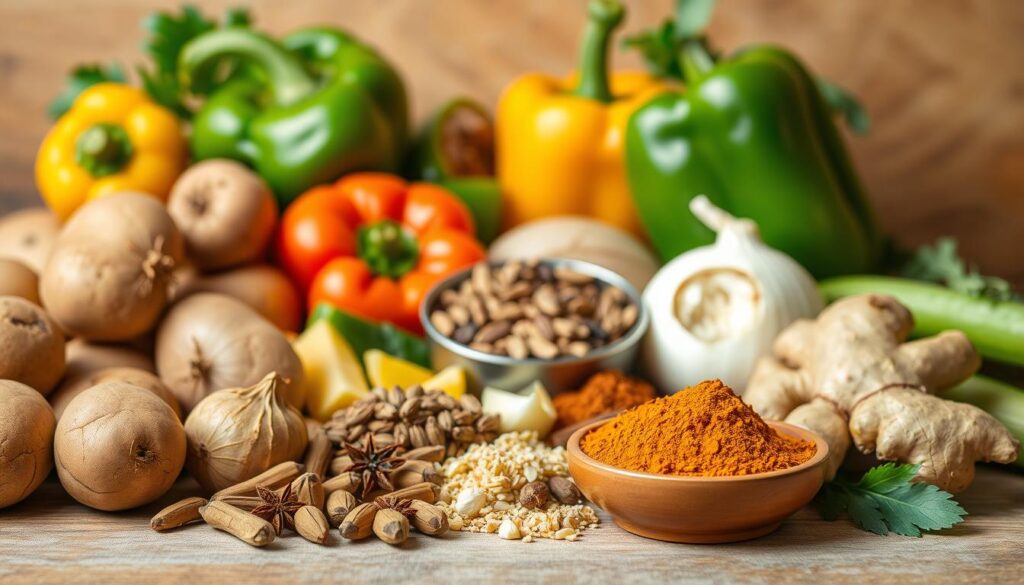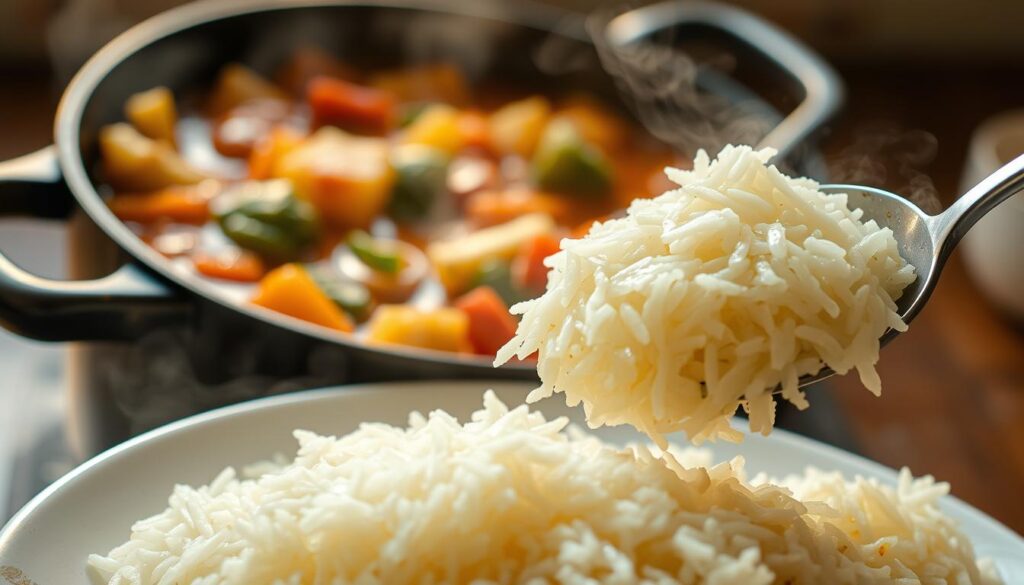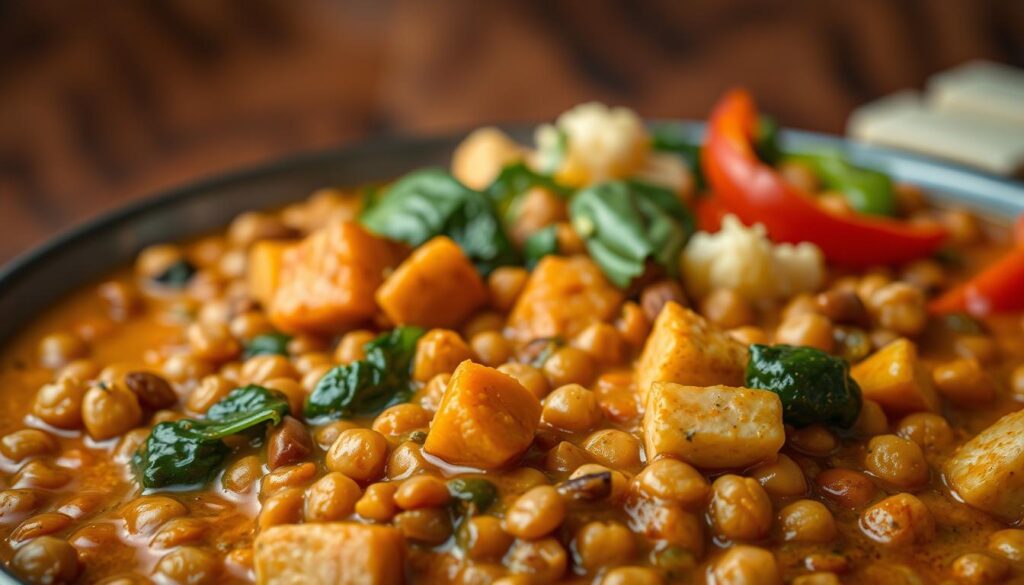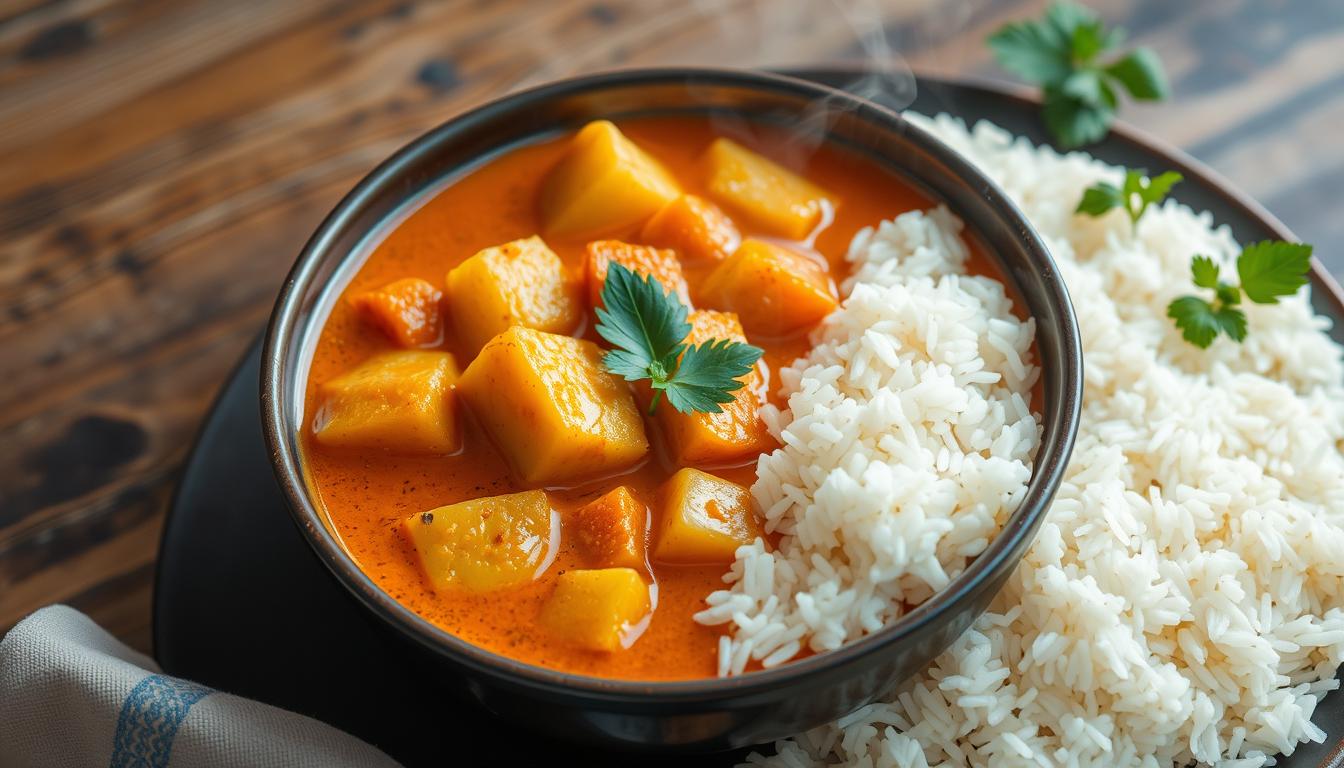Imagine stepping into a cozy kitchen. The air is filled with the scent of cumin, turmeric, and coconut milk. This vegetable curry with rice turns simple veggies into a comforting meal in under 30 minutes. It’s perfect for busy days or when you just want something cozy.
Picture chickpeas in a rich coconut sauce, sweet potatoes that melt in your mouth, and spices like cardamom and cayenne. This homemade vegetable curry is not just quick. It’s a burst of flavors that feels like a warm hug. Plus, it goes great with fluffy basmati rice, making every bite satisfying.
Key Takeaways
- Complete this vegetable curry with rice in 30 minutes: 10 minutes prep, 20 minutes cook.
- Customize with veggies like carrots, eggplant, or zucchini—swap in what’s fresh and what you love.
- Perfectly vegan, gluten-free, and soy-free, fitting any dietary preference.
- Uses pantry staples like coconut milk, curry powder, and pre-chopped veggies to simplify prep.
- Serve over rice or quinoa for a balanced, hearty meal without the hassle.
Why Vegetable Curry with Rice Makes the Perfect Weeknight Dinner
Craving a vegetarian curry that’s both comforting and quick? This healthy curry meal is perfect. It’s an easy curry dish that only needs 15 minutes of prep. Plus, it’s made in one pot, so cleaning up is easy.
Time-Saving Benefits of This One-Pot Meal
- Uses a skillet or sheet pan for minimal dishes
- 35-minute total cook time with passive oven time
- Works with frozen vegetables for last-minute meals
Nutritional Value in a Single Dish
Each serving has 155 calories. It’s packed with plant-based protein from chickpeas and fiber from kale and sweet potato. Turmeric adds anti-inflammatory benefits, and coconut milk makes it creamy without too much fat. It’s great for meal prep, lasting 4-5 days in the fridge or freezing well.
Customizable Options for Every Taste Preference
Try using seasonal veggies like zucchini or broccoli. Add tofu or peanuts for more protein. For spice, use green curry paste—mild for kids, more for those who like it hot. It’s fully vegan and gluten-free with tamari, fitting any dietary need while staying tasty.
Essential Ingredients for an Authentic Vegetable Curry
Every homemade vegetable curry begins with key ingredients that give it its unique taste. Coconut milk and quality spices are must-haves—they form the heart of any curry recipe. Here’s what you need for a flavorful vegetable curry:

| Category | Ingredients | Purpose |
|---|---|---|
| Aromatics | Yellow onion, ginger-garlic paste | Builds base flavor and sweetness |
| Spices | Curry powder, turmeric, cayenne | Deliver signature heat and color |
| Liquids | Coconut milk, vegetable broth | Thicken sauce and balance spice |
| Vegetables | Sweet potatoes, cauliflower, bell peppers | Provide texture and natural sugars |
| Extras | Lime, cilantro, spinach | Brighten flavors and add freshness |
For real flavor, use Field Day Organic Coconut Milk and Thai Kitchen Red Curry Paste. If you can’t find sweet potatoes, regular potatoes work too. But don’t skip the ginger-garlic paste—it’s crucial for that flavorful vegetable curry taste. Always toast whole spices like cardamom before grinding to enhance their aroma.
Make sure you have turmeric and cumin in your pantry. McCormick offers pre-ground spices for easy use. Adjust salt and acid (lime juice) last to bring out each ingredient’s role in your homemade vegetable curry.
Choosing the Right Rice for Your Curry Dish
Finding the perfect rice can make your rice and curry meal unforgettable. The right grain should match your vegetable curry with rice taste. Here are some top picks for any preference or dietary need.
Basmati Rice: The Traditional Choice
Basmati rice is known for its nutty smell and fluffy texture. Its long grains separate well, making each bite perfect. Rinse it and boil with 1.5 times water for a light base.
Grown mainly in India, basmati rice is loved for enhancing any curry. It balances spicy and mild flavors without overpowering them.
Jasmine Rice: A Fragrant Alternative
Jasmine rice has a floral scent and sticky texture. It’s great with coconut-based vegetable curry with rice. Its soft grains are perfect for thick curries.
Choose Thai jasmine for the strongest aroma. It pairs well with creamy coconut or turmeric dishes.
Brown Rice: The Healthier Option
Choose brown rice for more fiber and vitamins. Its earthy taste is good with bold curries. Cook it 20-25 minutes longer than white rice.
Try soaking grains first to save time. It keeps the nutty flavor. Brown rice is great for those who want nutrition without losing taste.
Quick-Cooking Rice Varieties for Busy Evenings
Instant or parboiled rice saves time. For a twist, try quinoa for its protein. Or mix in curry dish ideas like jeera rice or carrot-infused rice for sweetness.
Even cauliflower rice is a low-carb option. It works well with bold spices.
Kitchen Tools That Make Vegetable Curry Preparation Faster
Making a homemade vegetable curry is easy. The right tools make every step simpler. From prepping to cooking, here’s what you need for a quick curry.
Must-Have Utensils for Efficient Cooking
A sharp chef’s knife cuts prep time in half. It’s great for slicing onions or dicing potatoes. A heavy Dutch oven cooks evenly, preventing scorching.
Use a microplane grater for zesting citrus or ginger. Roasting veggies in a sheet pan before adding them to the pot helps with even cooking.
- Measuring spoons: Ensure spice blends are balanced without over-seasoning.
- Wooden spoon: Stir without scratching non-stick pans while building your curry base.
- Colander: Rinse frozen peas or drain canned coconut milk quickly.
Time-Saving Appliances Worth Using
Electric gadgets make steps quicker. A food processor chops onions and mushrooms fast. Pair your curry recipe with an Instant Pot for 70% less simmering time.
For easy rice, use a Zojirushi rice cooker. An immersion blender purees sauces instantly. These tools turn your kitchen into a curry-making powerhouse.
Stick to essentials like a silicone spatula for deglazing pans or a slotted spoon to drain lentils. These tools work together to make your curry-making process efficient and stress-free.
Prep Work: Getting Your Vegetables Ready in Under 10 Minutes
Getting your veggies ready quickly is key to a great homemade vegetable curry. Start by gathering your ingredients. Use frozen peas, pre-chopped onions, or store-bought ginger paste to save time. Vegetable curry with rice recipes work best with uniform pieces, so cut carrots and bell peppers into ½-inch cubes.
- Wash all veggies first to avoid cross-contamination.
- Peel potatoes and sweet potatoes last to prevent browning.
- Chop onions and garlic before cutting harder veggies like carrots.
For even faster prep, use frozen mixed vegetables (13 oz) or precut bell peppers. Add chickpeas after rinsing for protein without extra work. Chop extras on Sunday for future vegetarian curry batches. Keep minced ginger in your freezer for quick use. Also, freeze cilantro or parsley in oil-filled ice cube trays for garnishes. With these tips, your homemade vegetable curry is ready to cook in no time!
The Perfect Vegetable Curry with Rice: Step-by-Step Cooking Method
Learn to make this curry recipe in just four steps. Each step is crucial for the right mix of texture and taste in your flavorful vegetable curry.

Creating the Aromatic Base
- Heat oil in a large pot over medium heat until shimmering.
- Add onions and cardamom pods. Sauté 2-3 minutes until translucent and fragrant.
- Stir in turmeric, cayenne, and ginger-garlic paste. Cook 30 seconds until spices darken slightly.
Adding Vegetables in the Right Order
- Start with dense vegetables: sweet potatoes, carrots, and potatoes. Cook 5 minutes to soften edges.
- Add bell peppers and green beans last. Cook 3-4 minutes until crisp-tender.
- Stir in chickpeas and coconut milk for creaminess. Taste and adjust salt.
Simmering Your Curry to Perfection
Bring to a boil, then reduce to a gentle simmer. Cover and cook 15-20 minutes until vegetables are tender. Add water ¼ cup at a time if too thick.
Cooking Rice Simultaneously
Start cooking rice when adding root vegetables to the curry. Use this timing guide:
- Basmati rice: Start when root veggies begin cooking.
- Jasmine rice: Begin when adding coconut milk.
- Quick-cook rice: Cook as directed on package while curry simmers.
Serve with lime wedges and fresh cilantro. Adjust spice levels using the optional additions mentioned. This vegetable curry with rice serves 4-6 and freezes well in airtight containers. Reheat with a splash of broth for moisture.
Spice Levels: How to Adjust Heat According to Your Preference
Learning to control the heat in your flavorful vegetable curry is key. Whether you like it mild or hot, these tips help. They ensure your easy curry dish suits everyone’s taste. Here’s how to adjust the spice without losing flavor.
Mild Curry Options for Sensitive Palates
To reduce heat, cut the cayenne pepper in half. Replace half of the spice mix with sweet paprika. Add more coconut milk or honey to soften the taste. Try this in curry dish ideas like a sweet potato and spinach mix for a gentle yet rich taste.
Medium Heat Balancing Act
- Start with ½ tsp cayenne for 4 servings.
- Introduce yogurt or lime juice to cool it down mid-cook.
- Check the heat by tasting small amounts before adding more seasoning.
Bringing the Fire: Tips for Spice Lovers
For more heat, toast whole dried chilies in oil before grinding them into the sauce. Add fresh Thai chilies (2,000-5,000 SHU) or serranos (10,000-16,000 SHU) to taste. Serve with a yogurt dip for instant relief.
| Chili Type | Scoville Units |
|---|---|
| Jalapeño | 2,500–8,000 |
| Habanero | 100,000–350,000 |
| Ghost Pepper | 855,000–1,041,427 |
Pair bold curries with cooling garnishes like cilantro or mint for balance.
Creative Vegetable Combinations for Your Curry
Make your vegetarian curry stand out by choosing veggies wisely. Mix different textures and colors for a burst of flavor in every bite. Here are some curry dish ideas that use seasonal ingredients and cooking methods.
- Seasonal Mixes:
- Spring: Asparagus tips, sugar snap peas, and diced new potatoes.
- Summer: Grilled zucchini, roasted red peppers, and corn kernels.
- Fall: Butternut squash cubes, roasted Brussels sprouts, and caramelized onions.
- Winter: Parsnips, turnips, and leeks for a hearty homemade vegetable curry.
- Global Flavors:
- Thai-inspired: Baby corn, snow peas, and Thai basil.
- Mediterranean twist: Artichoke hearts, kalamata olives, and roasted red peppers.
- Function-Focused:
- High-fiber: Carrots, okra, and green beans.
- Antioxidant boost: Red/yellow bell peppers, cherry tomatoes, and purple cabbage.
Begin with dense veggies like sweet potatoes or cauliflower. They simmer for 10–15 minutes. Add delicate greens like spinach or bok choy in the last 3 minutes. Frozen peas add creaminess. Be bold—your vegetarian curry will love it!
Plant-Based Protein Add-ins to Make Your Curry More Filling
Make your vegetarian curry more filling with protein-rich ingredients. These add-ins not only boost nutrition but also improve the curry’s texture. Discover how to create a healthy curry meal that keeps you full for longer.

Tofu and Tempeh Options
- Press extra-firm tofu to remove moisture before cubing it and pan-frying for a meaty texture.
- Crumbled tempeh adds a smoky depth when sautéed before mixing into the curry base.
- Marinate tofu in soy sauce or turmeric for 20 minutes before cooking to enhance flavor absorption.
Legumes That Complement Curry Flavors
Chickpeas are a star here—1/2 cup adds 7g of protein. For creamier results, blend a portion into the sauce. Try these swaps:
| Legume | Protein (per ½ cup) | Best Use |
|---|---|---|
| Red lentils | 9g | Simmer until soft to thicken the sauce |
| Black beans | 7.5g | Add during the last 10 minutes of cooking |
| White beans | 8g | Mash part of the batch for creaminess |
Nuts and Seeds for Added Texture
Top bowls with toasted nuts for crunch or stir in seeds for a protein boost. Try:
- Cashews: Blend into the sauce for richness or sprinkle whole for crunch
- Pumpkin seeds: Add 3g of protein per tablespoon as a garnish
- Hemp hearts: Stir in at the end for 10g of protein per 3 tbsp
Mix and match these options to reach your daily protein goals while keeping your flavorful vegetable curry vibrant and nourishing.
Serving Suggestions and Garnishes That Elevate Your Dish
Make your vegetable curry with rice stand out with the right serving ideas. Serve it in wide bowls to show off its colors. Pair it with steamed rice, shaped into a mound, for a neat look.
- Drizzle 2 tablespoons of fresh cilantro over each bowl for freshness.
- Add a squeeze of lemon juice to brighten flavors before serving.
- Top with toasted coconut flakes or crispy shallots for textural contrast.
Choose sides that balance spice and texture:
- Offer a cooling yogurt raita or cucumber salad on the side.
- Pair with crusty sourdough or French bread for dipping—these hold curry sauce better than traditional naan.
- Experiment with tangy mango chutney or bright pea-green herb chutney.
Present meals on warmed plates to keep everything hot. For family-style meals, arrange dishes in the center so everyone can customize their portions. Add a sprinkle of kasuri methi for a traditional touch, or pomegranate seeds for color.
Customize further with these options:
- Swap rice for pilau rice or spinach-kitchari for a nutrient boost.
- Include a small bowl of toasted nuts or crispy onions as toppings.
- Pair with a simple green salad for added crunch.
Small tweaks can make a basic flavorful vegetable curry unforgettable. Adjust garnishes and sides to match spice levels—try lime wedges for heat balance or coconut cream for richness.
Storing and Reheating Your Vegetable Curry for Later Enjoyment
Keeping your vegetable curry with rice fresh starts with smart storage. Follow these tips to enjoy your easy curry dish all week or even later. They help maintain flavor and quality.
Refrigeration Guidelines for Maximum Freshness
Let your curry cool down before putting it in an airtight container. Store the rice by itself to avoid it getting soggy. It stays fresh for up to 4 days. Reheat each portion to keep the texture right.
Freezing Techniques for Meal Prep
- Divide into portions for quick thawing.
- Use freezer-safe containers; label with dates and contents.
- Press out air before sealing to avoid freezer burn.
- Freeze for up to 2 months. Note: Coconut milk may thicken or separate but will return to normal when reheated.
Best Practices for Reheatinging Without Losing Flavor
Reheat slowly to keep the texture:
- Stovetop: Simmer on low heat, adding a splash of broth if needed.
- Microwave: Use 50% power in 1-minute bursts, stirring between cycles.
- Oven: Bake at 175°C (350°F) for 10-15 minutes, covered, to evenly warm the dish.
Always check the center reaches 74°C (165°F) to ensure safety. Add fresh herbs like cilantro or lime juice after reheating for a burst of brightness.
Make Tonight Curry Night: Your New Go-To Comfort Food
When hunger hits, a vegetarian curry with rice is more than dinner—it’s a balanced meal for busy lives. Picture a healthy curry meal ready in 30 minutes, filled with roasted cauliflower, spinach, or sweet potatoes. It’s all simmered in a creamy coconut base.
This dish is not only quick but also a nutritional powerhouse. Each serving has under 400 calories and is rich in fiber from veggies like zucchini and red peppers.
Customize your bowl with rice and curry combinations. Try fragrant basmati rice with a Thai twist using lemongrass, or a Jamaican flavor with allspice and thyme. Even swapping chickpeas for tofu keeps meals fresh.
Worried about spice kits? Start with basics like turmeric, cumin, and garam masala. These staples make quick weeknight meals or bulkier batches for the freezer.
Let the Dutch oven do the work: roast veggies while the curry simmers, then serve with a squeeze of lime and cilantro. This meal has 8g protein per serving and no added sugars. It proves comfort food can be wholesome and easy.
Freeze leftovers, adjust spice levels, or mix in nuts for extra crunch. Your creativity is the only limit.
Ready to redefine dinner? Batch-cook rice and curry for lunches, or host a family “curry bar” with toppings like yogurt and chilies. Tag #CurryNight on social media and share your tweaks. This isn’t just a recipe; it’s a foundation for endless variations that taste like a high-end Indian restaurant, all in your own kitchen.

